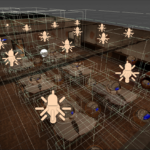The floor for the classroom presented a choice, to go with traditional wood floors or to have a carpeted floor. Eventually I decided to go with a wooden floor, but what kind of wood pattern to use?
Growing up in Switzerland, my home was comprised of mostly wood floors with stone being used where wood wasn’t. A majority of houses I have visited there shared these qualities, and the most common patterns of wood planks used were either herringbone or basket weave.

These patterns have always reminded me of my home and I decided to replicate one of these patterns for the classrooms floors. Eventually I decided on a herringbone pattern, as this was available in substance painter from a personal project.
The floor for the environment was comprised of one object, subdivided into 4 faces, each of these faces were unwrapped into a UDMI UV map, also known as a texture atlas. This method allows for the addition of tiles, each using their own UV space, where each tile can be assigned its own texture, in this case, it allows for the creation of a large texture. This method has many advantages, as you are able to create complex models with many textures on one UV map, or have detail dense areas use a 4K texture and less detailed areas use a 1K or 2K texture.

For the floor each tile was a different quarter of the base-mesh, this allowed for a large texture to be used, as well as for details to appear high quality and not blurry. This was then imported into unity, and applied to the floor.





